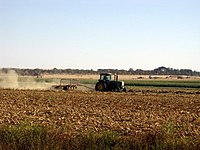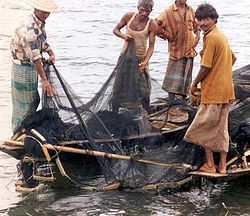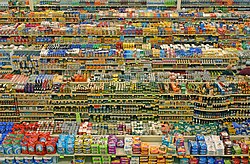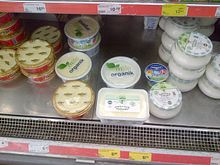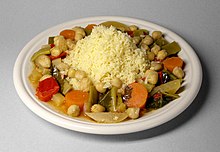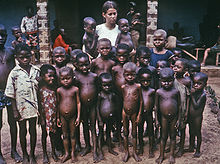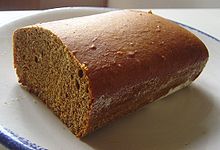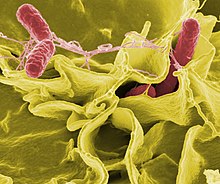Food
Food is any substance consumed to provide nutritional support to a living being. Food is usually of plant, animal, or fungal origin and contains essential nutrients, such as carbohydrates, fats, proteins, vitamins, or minerals. The substance is ingested by an organism and assimilated by the cells of the organism to provide energy, sustain life, or promote growth. Different animal species have different feeding behaviors that meet the needs of their unique metabolisms, often evolved to fill a specific ecological niche within specific geographic contexts.
In addition to nutritional purposes, human nutrition is associated with social and cultural, health and psychological aspects. Thus, for example, alcoholic beverages in human nutrition have no nutritional interest, but they do have a fruitive interest. Therefore, they are considered food. On the contrary, substances that are not ingested or that, once ingested, alter the metabolic functions of the organism are not considered food. Thus, chewing gum, tobacco, medicines, and other drugs are not considered food.
Food contains nutrients and non-nutrients, such as vegetable fiber, which, although it does not provide humans with matter and energy, favors digestion. Health foods are the object of study of various scientific disciplines: biology, and especially the science of nutrition, studies the mechanisms of digestion and metabolization of food, as well as the elimination of waste by organisms; ecology studies food chains; Food chemistry analyzes the composition of foods and the chemical changes they undergo when technological processes are applied to them, and food technology that studies the preparation, production, and handling of food products intended for human consumption, and some others. species depending on the nutritional value and properties.
Food sources
Almost all foods are of animal or plant origin, although there are some exceptions. Foods that do not come from animal or plant sources include various edible fungi, including button mushrooms. Fungi, environmental bacteria, are used in the preparation of pickled and fermented foods, such as leavened bread, wine, beer, cheese, pickles, and yogurt.
Many cultures consume algae, and even cyanobacteria such as spirulina. Additionally, salt is often consumed as a flavoring or preservative, and baking soda is used in food preparation. Both substances are inorganic and like water, an important part of the human diet.
Plants
Many plants or their parts are eaten for food. There are approximately 2,000 species of plants cultivated for food, and many have several distinctive cultivars. Plant-based foods can be classified as having the necessary nutrients for the initial growth of plants. As a consequence of this, the seeds are often full of energy, and are good sources of food for animals, including humans. In fact, the majority of all food consumed by humans is seed. This includes cereals (such as corn, wheat, and rice), legumes (such as beans, peas, and lentils), and nuts. Oilseeds are often pressed to produce oils, including olive, sunflower, canola, and sesame.
Fruits are the mature extensions of plants, which include the seeds inside. The fruits often look attractive to animals, so they eat them and excrete the seeds over long distances. Fruits are a significant part of the diet of most cultures. Some fruits, such as pumpkin and eggplant, are eaten as vegetables.
Vegetables are a second type of plant matter eaten as food. This includes root vegetables (such as potatoes and carrots), leaf vegetables (such as spinach and lettuce), stem vegetables (such as bamboo and asparagus), and flower heads (such as artichokes and broccoli). Many herbs and spices are highly flavored vegetables.
Animals
Animals can be slaughtered and used for food directly, or indirectly for the products they produce. It should be noted that the concept of animals that can be slaughtered by man includes: all species of livestock (cattle, pigs, sheep and goats), all types of poultry (chicken, turkey, duck, goose, etc.), as well as diversity of fish species and shellfish (crustaceans and molluscs). Meat is an example of a direct product taken from an animal, which comes from either the muscular system or from organs. Animal-produced food products include milk produced by mammals, which in many cultures is drunk or processed into dairy products such as cheese or butter. In addition, birds and other animals produce eggs, which are frequently eaten. Products obtained from bees are also usually included in the group: honey, a popular sweetener in many cultures, royal jelly and wax. Some cultures consume blood, some in the form of sausages, as a product to thicken sauces, or salted for times of food shortage, and others use a wide variety of edible offal: liver, kidneys, lungs, legs, etc.
Food production and acquisition
Since humans began to develop their ability to make tools, their techniques for obtaining food evolved to meet their demand. They began to replace harvesting with agriculture. All the civilizations that developed in antiquity developed techniques for irrigation, storage and cultivation of plant products, as well as livestock that allowed them to obtain food from land animals, based on the domestication of animals such as cows, sheep, horses or the dog; and fishing that allowed him to obtain food from the sea.
Today, in developed nations, the food supply increasingly depends on intensive agriculture, factory farming, fish farming or other techniques that increase the amounts of food produced while decreasing its cost. These techniques in turn depend on the development of mechanized tools, from the threshing machine and seed drill to the tractor and thresher. These tools have been combined with pesticides that ensure high crop yields and fight insects or mammals that harm production. However, modern techniques are not widely distributed in countries where agriculture is potentially exploitable, such as in several countries in equatorial Africa, South Asia or Latin America.
Genetically modified edible plants (GMOs) have also been used to make them more resistant to diseases and parasites, as well as more productive. These techniques are highly contested, since they leave the production of seeds in the hands of multinationals, while it is assumed that the cross-pollination of natural plants by modified plants can alter their quality.
More recently, there has been a growing trend towards more sustainable agricultural practices, which use natural production systems. These methods, which are spreading thanks to consumer demand, stimulate biodiversity, local self-security and organic farming.
Animal sacrifice
The preparation of foods of animal origin that are inside the meat products, implies the sacrifice of the animals. Slaughter techniques are relatively new, since until the hydraulic revolution of the XIX century, butcher shops in European and American cities sacrificed animals in full public thoroughfare, so the remains of pigs, goats, cattle and birds ended up on the streets. Later, people dedicated to this, collected the bones and entrails of animals that were either in a well, or from the same street to give it other uses: the bones of the animals were crushed and compost was made from them. Currently the process has become more complex, including various stages: slaughter, evisceration, hanging, partitioning or cutting and distribution. In developed countries, it is carried out in a specialized building (slaughterhouse) used for mass processing of animals; these slaughterhouses are regulated by law only in some countries; In the case of the United States, the 1958 Act was established: Human Sacrifice, which specifies that an animal must be stunned or beaten before being sacrificed. This act, like many others in various countries, is exempted in various religious laws, such as kosher. Strict interpretations of Kashrut require the animal to be fully conscious when its carotid is severed.
Restaurants and cafes
Some cultures produce food to sell to restaurants, and have them distribute it in a more specific way, for which consumers pay. These restaurants often have trained chefs who prepare the food, while servers serve customers. The term restaurant comes from a French word used in France in the XIX century. However, before the coining of the term, the idea of an establishment that served several people, while all the food was prepared in the kitchen, given from other places and earlier dates: both in the city of Pompeii and in the China of the Song dynasty; in the various Hispanic countries, these establishments were formerly called fondas. Cafés, later called cafeterias, of the 17th century were small establishments where only coffee was served in various presentations and with various accompaniments, and is considered an early version of restaurants.
Packaged food
It is increasingly common to buy food through self-service stores (open 24 hours), sundries or supermarkets. For this to be feasible, it is necessary that they be packaged (in the case of solid foods) or bottled (for solid or liquid foods). The most common packages are plastic (hermetically sealed bags in which box bread or ground bread, grains such as rice or corn are sold; or, plastic bottles, in which juices, soft drinks, milk are stored or water), paper (bags closed with non-toxic glue, such as flour), boxes (cereals, some juices or milk, cookies, etc.) or metal (aluminum or tin cans or bags).
Exports and imports
The World Bank reported that the European Union was the main importer of food in 2005, followed at a good distance by the United States and Japan. Currently, food is traded and marketed globally. The variety and availability of food is no longer restricted by the diversity of foods grown locally or by the limitations of the local growing season. Between 1961 and 1999 there has been a 400% increase in global food exports. Currently some countries are economically dependent on food exports, which in some cases account for more than 80% of all exports.
In 1994, at the Uruguay Meeting, more than 100 countries became signatories to the General Agreement on Tariffs and Trade in a dramatic increase in trade liberalization, which included an agreement to reduce subsidy payments to farmers, propped up by the World Trade Organization in the application of agricultural subsidies, tariffs, import quotas and the settlement of trade disputes that cannot be resolved bilaterally. Where trade barriers are erected over disputes in matters of public health and security, the WTO refers the dispute to the Codex Alimentarius Commission, which was founded in 1962 by the Food and Agriculture Organization of the United Nations and the World Health Organization. Trade liberalization has greatly affected world trade in food.
Marketing and retail sales
The food market unites the producer with the consumer. It is the chain of activities that brings food from “farm gate to plate.” Marketing a single food product can be a complicated process involving many producers and companies. For example, 57 companies are involved in the manufacture of canned chicken noodle soup. These businesses include not only the chicken and vegetable processors but also the companies that transport the ingredients and those that print the labels or manufacture the cans. The food marketing system is the largest non-governmental employer both directly and indirectly. in the U.S.
In the pre-modern era, the sale of surplus food took place once a week when farmers brought their wares to the local food market on market day. There the food was sold to shopkeepers who in turn resold it in their stores where it was bought by local consumers. With the beginning of industrialization and the development of the food processing industry, it could be distributed and sold in localities. distant a greater variety of foods. The first grocery stores were counter stores, in which shoppers asked the clerk for what they wanted, and the clerk fetched it for the shopper.
Supermarkets were born in the 20th century. Supermarkets implemented the idea of self-service shopping, using market carts and offered quality food at a lower price thanks to reduced personnel costs and economies of scale. In the latter part of the twentieth century, this has been further revolutionary by the development of huge warehouse-sized supermarkets located on the outskirts of cities selling a wide variety of foods from around the world.
Unlike food processors, food retailing is a two-tier market in which a small number of very large companies control a large portion of supermarkets. Giant supermarkets wield great buying power over farmers and processors and a strong influence over consumers. Yet less than 10% of what consumers spend on food goes to farmers, with large percentages going to advertising, transportation, and intermediary corporations.
Organic food
It is called organic food, organic food, or organic food to the agricultural or agro-industrial product produced under a set of procedures called “ecological”. In general, ecological methods avoid the use of synthetic products, such as pesticides, herbicides and artificial fertilizers.
The ecological farming movement emerged in the 1940s as a response to the industrialization of agricultural production called the green revolution. At present, ecological farming, as well as ecological livestock, is a heavily regulated industry, which in countries such as Japan, Canada or the European Union requires special certifications to market its products.Meals
While there are foods that can be consumed as they are obtained (raw), others need to be processed for safety reasons, or simply for organoleptic reasons (to improve the smell, flavor or color); These types of methods can be very simple, such as washing, cutting, garnishing or mixing food. When all these procedures come together, it is said that a meal is being prepared.
A meal is a mixture of one or more foods subjected to a physical or chemical process, or both. The physical processes include cutting, mixing, crushing, liquefaction (mixing by cutting blades), etc. Among the chemical processes, are cooking, fermentation, these being the most common.
The technique of measuring, preparing and perfectly combining ingredients to form a dish, as well as seasoning, is known as culinary art.
Kitchen
The term cooking encompasses a large set of methods, tools and ingredients to improve the taste or digestibility of food. The technique of cooking, called the culinary art, generally requires the selection, measurement, and combination of ingredients in an orderly process to achieve the desired result. All this is coupled with the variety of ingredients, environmental conditions, tools and, of course, the skill of the cook. The kitchen is a cultural element that characterizes a nation or region from the rest of the world; The reasons one food is recognizable from another is its geographic environment, which includes the species of plants and animals in the region, the climate, and the nutritional needs of the inhabitants. Political, economic and religious factors also matter.
Cooking involves the application of heat to a food that, usually, chemically transforms it, altering the flavor, texture, appearance and nutritional properties. Cooking involves subjecting food to different culinary techniques, generally applying heat in one way or another. Cooking, properly speaking, is not the same as roasting, since it necessarily requires the immersion of the food in water, a technique that has been practiced since the tenth millennium BC. with the introduction of pottery. There is archaeological evidence that Homo erectus roasted food in their camps; Roasting is the direct application of heat or fire to food, without water appearing as an intermediary.
Gastronomy
The gastronomy (from the Greek γαστρονομία [cuisine], of the gastro prefix = stomach and suffix -nomy = norm, rule.) is the art that studies the human relationship with its food and its environment or environment. Gastronome is the individual who cares about this art. It is often mistakenly believed that the term gastronomy only relates to culinary art and the bookshop around a table. However, this is a small part of the field of study of this discipline: it cannot always be said that a cook is a gastronomist. Gastronomy studies various cultural components, taking as a central axis the food.
Gastronomy in addition to studying how people are connected in terms of their nutrition, it also studies their origins this means that factors such as customs, place, religious creed and history are studied, these four components are also the objects of studies that gastronomy uses to thoroughly study their origin. "In gastronomy, preparation techniques, cooking times and ingredients are involved in preparing a recipe."Diet
The diet diet diet or eating habit is the composition, frequency and amount of food and beverages that constitutes the feeding of living beings by forming habits or nutritional behaviors.
In the case of human food, the diet presents large historical and geographical variations according to cultural, individual, environmental, economic, family, food availability and others. The relationship between diet and health is widely studied by modern medicine and a large number of diets have been defined, either to stay healthy physically and mentally, to correct health problems or to modify constitutional characteristics. These definitions include the characterization of the nutrients, their quantity and the frequency of consumption, as well as metabolic and physical parameters that constitute their objective purposes, such as, for example, maintaining or achieving a certain body weight in relation to the stature and physical constitution (body mass index).
The human diet is considered balanced if it provides nutrients and energy in such amounts that allow the body to maintain its functions in a context of physical and mental health. This balanced diet is particular for each individual and adapts to their sex, age, weight and health situation. However, there are several factors (geographic, social, economic, pathological, etc.) that influence the balance of the diet.
Diets (cantities and varieties of foods to be consumed), are used for the treatment and prevention of various pathologies (dietotherapy) and for Etymologically the word "dieta" comes from the Greek daytawhich means ‘regimen of life’. It is accepted as a synonym for food, which alludes to the ‘set and quantities of foods or food mixtures that are usually consumed’. It may also refer to the regime which, in certain circumstances, perform healthy, sick or convalescent people in eating, drinking and sleeping. feeding to various physiological situations.
In nutrition, the diet is the sum of meals made by a person or another organism, while dietary habits make up the diet pattern that follows daily, this includes food preferences, the family and cultural influence on the individual in terms of the food they eat. Although humans in general are omnivorous, each culture maintains preferences and myths about some foods. On the other hand, such individual food preferences may be or may not be nutritionally healthy. A balanced diet requires a varied ingestion of food in order to obtain the appropriate amounts of energy and nutrients.
Food habits involve a significant role in the health and disease of an individual, which are conditioned by various factors (the state of health, the economic situation, society, culture and religion).Cultural and religious diets
Dietary habits are the habitual decisions that a person or culture makes when choosing the foods to eat on a regular basis. Although humans are omnivores, many cultures maintain some food preferences and food taboos. Also some diets are defined by culture or religion. For example, only kosher foods are allowed by Judaism and halal/haram foods by Islam, in the diet of believers. Dietary habits in different countries or regions have different characteristics, closely related to a culinary culture.
Dietary Deficiencies
Dietary habits play a significant role in the health and mortality of all humans. The imbalance between fuel consumed and energy expended results in starvation or excessive stores of adipose tissue, known as body fat. Poor intake of various vitamins and minerals can lead to diseases which can have far-reaching effects on health. For example, 30% of the world's population has, or is at risk of developing, iodine deficiency. It has been estimated that at least 3 million children are blind due to vitamin A deficiency. Vitamin C deficiency results in scurvy. Calcium, vitamin D, and phosphorus are interrelated; the consumption of each can affect the solution of the others. Kwashiorkor and marasmus are childhood disorders caused by loss of dietary protein.
Healthy, moral and ethical diet
Many individuals limit the foods they eat for moral reasons or other habits. For example, vegetarians choose not to consume foods of animal origin to different degrees. Others choose a healthier diet, avoiding sugars or animal fats and increasing their intake of dietary fiber and antioxidants. Obesity, a serious problem in the Western world, increases the possibility of developing heart disease, diabetes, and many other diseases. More recently, dietary habits have been influenced by the concern that some people have about the possible impact on health or the environment of the use of genetically modified foods. An additional concern about the impact of industrial agriculture on animal welfare, human health and the environment is also having an effect on contemporary human dietary habits. This has led to the rise of a counterculture with a preference for organic and local foods.
Nutrition
Between the extremes of optimal health and death from starvation or malnutrition, there are a number of disease states that can be caused or ameliorated by changes in diet. Deficiencies, excesses or imbalances in the diet can have a negative impact on health, which can lead to diseases such as scurvy, obesity or osteoporosis, as well as psychological or behavioral problems. The science of nutrition tries to understand how and why specific aspects of the diet influence health.
Nutrients in food are grouped into several categories. Macro nutrients: lipids (fats), proteins and carbohydrates. Micronutrients: vitamins and minerals. Additionally, food contains water and dietary fiber.
Nutrients
A nutrient or nutrient is a chemical from the cell and it needs to perform its vital functions. It is taken by the cell and transformed into cellular constituents through a metabolic process of biosynthesis called anabolism, or is degraded to obtain other molecules, energy and nutrients.
We call food to all substances that live beings need to carry out their vital functions. Foods contain nutrients that are substances with direct or indirect function in cell activities that no other substance can perform.
Nutrients are any chemical element or compound necessary for the metabolism of a living being. In other words, nutrients are some of the substances contained in foods that are actively involved in metabolic reactions to maintain all the functions of the organism.
From the point of view of botany and ecology, the basic nutrients are the oxygen, water and minerals necessary for the life of the plants, which through photosynthesis incorporate the living matter, thus forming the basis of the food chain, once these vegetables are to serve as food to the animals. But, after the harvests, the plant takes with it the nutrients it extracted to grow. In order for soil to recover optimally, it is essential to use fertilizers; natural or synthetic products that replenish the nutrients that plants need to grow again. Granulada Urea is the fertilizer that best replenishes nitrogen to the soil.
Living beings that do not have photosynthetic capacity, such as animals, fungi and many protoctists, feed on plants and other animals, either alive or in decomposition. For these beings, nutrients are the organic and inorganic compounds contained in food and that, according to their chemical nature, are classified into the following types of substances:
- Proteins
- Glucids
- Lipids
- Vitamins
- Sales minerals
- Water
Macronutrients
Carbohydrates
Carbohydrates are sugars made up of monosaccharides. Carbohydrates are classified by the number of sugar units: monosaccharides (such as glucose, fructose, and galactose), disaccharides (such as sucrose, lactose, and maltose), and polysaccharides (such as starch, glycogen, and cellulose).). Carbohydrates provide energy for longer than fats.
Protein
Proteins are organic compounds consisting of amino acids linked by peptide bonds. The body cannot make some of the amino acids (called essential amino acids). Proteins create enzymes, keratin, energy, antibodies, increase the immune system and help cell growth and development. In nutrition, proteins are broken down by pepsin to free amino acids during digestion.
Fats and lipids
Fats consist of a glycerin molecule with three fatty acids attached to it. Fatty acids are a long, linear, unbranched hydrocarbon chain, connected by only single bonds (saturated fatty acids) or by single and double bonds (unsaturated fatty acids).
Fats are necessary to maintain proper function of cell membranes, to insulate the viscera against shock, to keep body temperature stable, and to keep hair and skin healthy. The body does not make certain fatty acids (called essential fatty acids) and the diet must supply them.
Fats have an energy content of 37.7 kJ/g (9 kcal/g); proteins and carbohydrates have 16.7 kJ/g (4 kcal/g). Ethanol has an energy content of 29.3 kJ/g (7 kcal/g).
Lipids regulate body temperature by insulating, and provide energy to the body.
Micronutrients
Mineral salts
Mineral salts are all those compounds called neutral salts, in which all replaceable hydrogens are replaced by metal ions. The most important salt that can be obtained in any diet is sodium chloride (NaCl), or table salt, and its addition is very common by the majority of the population. Table salt has been associated a lot with the flavor of food, which is why many people consume it in all their dishes, so much so that the food tastes bland without salt. Some problems such as high blood pressure or obesity are related to excessive salt intake, since sometimes up to 15 g of salt is consumed per day, when the recommended dose is 6 g. As an alternative to excessive salt intake, compounds such as potassium chloride (KCl) or ammonium chloride (NH4Cl) have appeared on the market.
Mineral salts of any kind are important to consume because they maintain a correct metabolic balance by being together with sugars. In addition to helping to retain water in the body to avoid dehydration and in case there is a shortage of fluid or the body has diarrhea.
Vitamins
Vitamins are generally very complex chemical compounds, of a different nature, but they have in common that surprisingly small amounts are essential for the functioning of the body. The absence of some vitamins causes diseases that can be serious, and the intake of very small amounts (milligrams) can correct this problem. Fruit peels are an important source of some vitamins. There are two types of vitamins:
- Liposoluble: dissolved in fat and found in fat-containing foods. Being able to store in fat is preserved in the body, so its consumption does not have to be daily. Excessive consumption of this type of vitamins is diverse and depends on the type of vitamin, with vitamin poisoning constant.
- Hydrosoluble: dissolved in water and the body requires constant consumption. Vitamin B12 is the most complex; however, these vitamins (all of those in group B and vitamin C) are fragile and easily expelled from the body.
While there is a popular belief that vitamins can cure everything from colds to cancer, it is now known that they are easily eliminated and not absorbed by the body, and that some fat-soluble vitamins cancel out water-soluble vitamins.
| Vitamin | Type of vitamin | Foods where it is located | Metabolic function | Effects on deficiency |
|---|---|---|---|---|
| A (retinol) | Liposoluble | Vegetables, dairy, liver | Essential component of light-sensitive pigments. Skin maintenance. | Various types of blindness and dryness of the skin. |
| B1 (thiamin) | Hydrosoluble | Pig meat, food, legumes, cereals. | Metabolism of carbohydrates. Regulation of nerve and heart functions. | Beriberi (bad muscle function, alteration of coordination and heart failure). |
| B2 (riboflavina) | Hydrosoluble | Milk, liver, eggs, cereals. | Metabolism of lipids, proteins and carbohydrates. | Eye irritation and epidermal dryness. |
| B3 (niacina) | Hydrosoluble | Magra meat (white or fat-free), cereals, legumes. | Redox reactions in the breathing process. | Dermatitis, diarrhea and mental disorders. |
| B5 (pantothenic acid) | Hydrosoluble | Milk, eggs, liver, legumes, cereals. | Metabolism of complex compounds in the organism. | fatigue and loss of coordination. |
| B6 (piridoxine) | Hydrosoluble | Cereals, vegetables, meats. | Metabolism of amino acids. | Alterations in the skin, seizures, kidney stones and protein deficiency. |
| B12 | Hydrosoluble | Red meats, eggs, dairy. | Metabolism of nucleic acids. | Anemia and neurological disorders. |
| Biotin | Hydrosoluble | Cereals, vegetables, meats. | Synthesis of fatty acids and metabolism of amino acids. | Depression, tiredness, dizziness, nausea. |
| C (ascorbic acid) | Hydrosoluble | Citrus, green leaf vegetables, chili, vegetables and tubers. | Collagen formation, tooth coating, bones and connective tissues. | Scork (inflammation of gums) |
| Folic acid | Hydrosoluble | Integral foods, fiber, vegetables and vegetables. | Metabolism of nucleic acids, auxiliary in the development of embryos and not natos. | Anemia, diarrhea, pregnancy complications and congenital malformations. |
| D2 and D3 | Liposoluble | Milk, eggs, fish liver oil, ultraviolet light. | Calcium absorption (Ca) and bone formation. | Rachitism. |
| E | Liposoluble | Margarine, seeds, vegetables. | Cell membrane antioxidant and fatty acids. | Anemia. |
| K | Liposoluble. | Green leaf vegetables. | Blood clotting. | Blood clotting inhibition. |
Inorganic compounds
According to the way in which a food arises in nature, the presence of certain inorganic compounds such as minerals or chemical elements is inherent in them. Organisms are unable to produce inorganic compounds (compounds whose basic structure is not carbon). Within the inorganic compounds we have minerals, and they are also classified, in a separate group, to water (H2O), carbon dioxide (CO2), nitrogen (N2), phosphorus (PO4−3) and sulfur (S2).
Minerals
Inorganic minerals are necessary for tissue reconstruction, enzymatic reactions, muscle contraction, nerve reactions, and blood clotting. Minerals must be acquired through the diet, contained in various foods, the main suppliers of minerals being plants. These are divided into two classes:
- Macroelements: they are of extreme abundance in food and the organism needs them throughout life.
- Calcium (Ca): it is essential to develop the bones and maintain their stiffness; it also serves to rebuild the cytoskeleton and improve nervous excitability. The calcium strength that the body has at birth is metabolized quickly, so the consumption of this is important all life.
- Magnesium (Mg): in particular, human metabolism requires this mineral to make the function of the organism the right one. However, its function in any other living being lies in the activity it has in the nervous system, as it helps to maintain the electrical potential of nerve cells and muscle fibrous cells (such as the heart). Magnesium deficiency is inevitable in those who are alcoholic or who use drugs with effects similar to opium, which can present tremors and seizures. Magnesium is obtained from meat and cereals.
- Sodium (Na): Sodium is naturally present in any food, and humans get it quickly in salty meals. Sodium has a regulatory role in extracellular fluid, whose excess can produce edemas. Finally, sodium excess can generate high blood pressure.
- Yodo (I): almost all vertebrates have thyroid glands, located in the previous part and on each side of the trachea, and for the gland to properly synthesize the hormones the action of the iodine is required. Insufficiency of iodine in the course of life generates fools and their insufficiency during pregnancy generates mental deficiency in the child.
- Iron (Fe): it is required for the formation of hemoglobin and therefore the proper transport of oxygen. Despite being indispensable to the organism, the digestive system is incapable of assimilating it efficiently. In the case of mammals, the male acquires sufficient iron in a natural way when its diet is adequate, instead the female, requires the double of the iron consumed by the man during the menstrual stage, since in the endometrial there is considerable iron.
- Microelements: are minerals that the body requires in tiny quantities and that are required to maintain good health. Little is known about its function, however, the effects of its absence are well known, especially in animals.
- Copper (Cu): occurs in many enzymes and proteins of the blood, brain and liver. Its absence prevents the absorption of iron, and can generate leukemia.
- Zinc (Zn): is important in the formation of enzymes. It is associated with growth, so many cases of enanism are related to zinc insufficiency.
- Fluor (F): it is known that fluoride is deposited in the bones and is fundamental to the growth of the bones. It is currently considered that including it in the diet helps to assimilate calcium. Water fluorization has shown that the wear of teeth, bones and cartilages is considerably reduced to 40%.
Additives
Additives are substances whose function is to provide organoleptic characteristics different from the natural ones of a food, such as color, smell and flavor; or, extend the useful or shelf life of that product.
Additives are classified into groups according to the physical or chemical alteration they generate, thus having 7 groups of additives:
Group 1: dyes
This includes all those substances that alter the color, whether chemical or natural. Within the natural dyes we have chlorophyll, carotenoids or thiocyanines. Among the chemicals, mineral compounds such as calcium and iron salts can be considered, which in addition to being good colourings, provide nutritional value.
Group 2: preservatives
Preservatives are used to prevent pathogenic microorganisms from proliferating or poisoning a product, thus increasing its shelf life. Among the best preservatives, we can include: sorbic acid, benzoic acid (and their respective salts, sulfur dioxides, nitrites and nitrates). Preservatives also fulfill the function of stopping fat rancidity or protein denaturation. There are 3 types of preservatives in food: natural, physical and chemical.
The natural ones are those such as salt, vinegar (either white or apple) and smoke (an example would be smoked food), the physical ones are sterilization and pasteurization and there are several chemicals, such as benzoate of sodium.
Group 3: antioxidants
Fats are compounds that oxidize very easily, this phenomenon is called rancidity. The presence of oxidation can denature fat-soluble vitamins. Among the main antioxidant compounds, we can mention the esters of gallic acid and butyl-hydroxytoluene. It is important to note that antioxidant compounds used in food also have effects in the human body.
Group 4: acidity regulators
Foods that have gone through a fermentation process (such as yogurt) require special attention to prevent the acidity from continuing to rise. Any type of hydroxides are used, however, not all of them have a legalization in their use (varying in each country). On other occasions, acids serve to flavor a product, for which their addition is dispensable, but to prevent the medium from continuing to lower the pH of the product, it is recommended that neutralizers be added once the flavor has been fixed. An additional function of acids is their incredible antimicrobial action, so once controlled, the acids used must be neutralized.
Group 5: stabilizers and emulsifiers
In this group of additives we can mention all those substances that help oils and fats to dissolve with water and form soft emulsions. Likewise, they are used to increase the duration of baked goods. Lecithin is the most widely used commercial stabilizer, while vegetable gums and pectin are perfect emulsifiers.
Group 6: anti-caking agents
These prevent powders (salts, flours and others) from becoming stone or compact due to the presence of moisture. Empirically, rice works as an anti-caking agent for kitchen salt. Polyphosphates and silicates are used.
Group 7: sweeteners
Its function is to increase the flavor of a substance: sweeteners, acidifiers, extracts and others.
Food aid
Food aid can benefit people experiencing food shortages. It can be used to improve people's lives in the short term, such that a society can increase its standard of living until such time as food aid is no longer needed. On the other hand, mismanaged food aid can create problems. by breaking into local markets, depressing the price of crops and discouraging food production. Sometimes a cycle of dependency on food aid can develop. Its provision, or the threat of its cessation, is often used as a political tool to influence the policy of the recipient country, a strategy known as food policy. Sometimes the conditions for giving food aid include that certain types of food be purchased from certain vendors, and food aid may be misused to improve the donor country's import markets. International efforts to distribute food to the world's most those in need are frequently coordinated by the World Food Programme.
Famine and Hunger
Food deprivation leads to malnutrition and ultimately starvation. This is frequently related to famine, which means the absence of food in entire communities. It can have a widespread and devastating effect on human health and mortality. Rationing is sometimes used to distribute food in times of scarcity, often times of war.
Starvation is a major problem internationally. Approximately 815 million people are malnourished and more than 16,000 children die every day from hunger-related causes. Food deprivation is considered unmet need, according to Maslow's Hierarchy of Needs and is measured using the famine scale.
Right to food
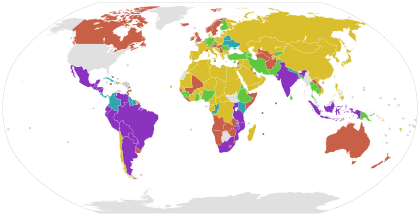
Adopted or developing a framework law (19). Constitutional, explicit as a right (23). Constitutional, implicit in broader rights or as a guiding principle (41). Direct applicability via international treaties (103). Commitmentd ratification of the International Covenant on Economic, Social and Cultural Rights (160). No status is known.Note: The same country may belong to several categories; the color given to a country corresponds to the highest category in which a country is located.
The right to food is a human right that protects the right of people to eat with dignity, which means that there is sufficient food available, that people have the means to access them and that adequately meet the dietary needs of individuals. The right to food protects the right of all human beings not to suffer from hunger, food insecurity or malnutrition. The right to food does not imply that Governments have an obligation to provide free food to all who wish it, or the right to be fed. However, if people are deprived of access to food for reasons beyond their control, for example, because they are detained, in times of war or after natural disasters, the right requires the government to provide food directly.
The right derives from the International Covenant on Economic, Social and Cultural Rights, which had the subscription of 170 States parties in April 2020. States that sign the pact agree to take measures to the maximum extent of their available resources to progressively achieve the full realization of the right to adequate food, both at the national and international levels. In a total of 106 countries, the right to food is applicable through constitutional arrangements in various forms or through the direct applicability in the law of several international treaties protecting the right to food.
At the 1996 World Food Summit, Governments reaffirmed the right to food and pledged to halve the number of hungry and undernourished people from 840 to 420 million by 2015. However, the number has increased in recent years, reaching an infamous record in 2009 of more than one billion undernourished people worldwide. In addition, the number of people suffering from hidden hunger (carnations of micronutrients that may cause a delay in the physical and intellectual growth of children) is more than 2000 million people worldwide.
While under international law states are obliged to respect, protect and fulfil the right to food, practical difficulties in ensuring this human right are demonstrated by prevalent food insecurity worldwide and ongoing disputes in countries such as India. In food-related regions (Africa, Asia and South America), there is not only food shortages and lack of infrastructure, but also poor distribution and inadequate access to food.Food safety
Foodborne illnesses, commonly known as food poisoning, are caused by bacteria, toxins, viruses, parasites, and prions. About 7 million people die from food poisoning each year, with approximately 10 times as many suffering from non-fatal poisoning. The two most common factors that lead to cases of bacterial foodborne illness are cross-contamination of food. ready-to-eat food from other raw foods and inadequate temperature control. Less commonly, acute adverse reactions can also occur if chemical contamination of food occurs, for example from improper storage or the use of non-food grade soaps and sanitizers. Food can also be adulterated by a very wide range of items (known as foreign bodies) during farming, manufacturing, cooking, packaging, distribution, or sale. These foreign bodies can include pests or their waste, hair, cigarette butts, wood chips, and any other class of contaminants. Certain types of food may become contaminated when stored or sold in unsafe containers, such as a ceramic jar with a lead-based glaze.
Food poisoning has been a recognized disease of the common man since as early as Hippocrates. The sale of stale, contaminated or adulterated food was a common practice until the introduction of hygiene, refrigeration, and worm control in the 19th century. XIX. The discovery of techniques to kill bacteria using heat and other microbiological studies by scientists such as Louis Pasteur contributed to modern health regulations that are ubiquitous in developed countries today. The works of Justus von Liebig, also contributed to the development of modern methods of storage and preservation of food.[52] In more recent years, a greater understanding of the causes of foodborne illnesses has led to the development of more systematic studies such as Hazard Analysis and Critical Control Points (HACCP), formerly ARICPC (Risk Analysis and Control Points). Critical Control), which can identify and eliminate many risks.
Contaminants
Since a food is produced (agricultural, livestock, fishing, etc.) or manufactured (any manufactured food: bread, cheese, among others), it has risks of being contaminated. When a food becomes contaminated, it is because the food has acquired new properties that are harmful to human health. A food can have three types of contamination:
- Biological: It is the most common contamination, and is presented at any stage of the food consumption process. Since it occurs, it can be contaminated with pathogenic microorganisms or hydrolysed by essential food molecules and enriched it, such as manufactured, packaged and sold if during these conditions are lacking adequate hygienic conditions.
- Chemistry: This contamination consists of adding to foods substances that are intended to alter a chemical. Some unapproved additives, such as artificial dyes, constitute chemical contamination. These contaminants can be toxic or exacerbating, allergens among others. For example, some soft drinks have colorants that exacerbate (do hyperactive, anger, or disease prone) children.
- Physics: It is described as physical contamination the alteration generated by non-food foreign objects or particles, for example glass squirles, screws, tools, metal particles, wood, threads, insects, etc.
Perishability
The perishability is the time it takes for a food to begin to degrade, losing its nutritional properties. Also known as expiration. According to that duration, foods are classified as:
- Perishable foods: They are those who start a decomposition in a simple way. Agents such as temperature, humidity or pressure are determining for food to begin its deterioration. Examples of these are: the derivatives of animals and vegetables, the fruits being the most perishable, and the milk and meats of less perecibility since they are preserved in refrigeration.
- Semi-perishable foods: These are those in which the deterioration depends on the humidity of the air and the microbial quality of it. Examples of these are nuts, tubers and other vegetables, such as grams.
- Non-perishable foods: They do not deteriorate with any of the above factors, but depend on other factors such as sudden contamination, mistreatment of the same, accidents and other conditions that are not determined by it. Example of these are flours, pastas and sugar, which are considered to be decayed once they are returned with some contaminant or begin their decomposition once cooked.
It is important not to confuse the expiration date with the best before date on food labeling. The first indicates when a food should not be taken because it endangers health, while the second only indicates the probable loss of properties of the product.
In perishable foods, their transportation is an essential part. It is important to know the legislation and regulations that govern the transport of perishable food.
Allergies
Some people have allergies or sensitivities to certain foods, which are not a problem for other people. This occurs when the person's immune system mistakes a protein in the food for a harmful foreign agent and attacks it. Approximately 2% of adults and 8% of children have food allergies. In a food, the amount of the allergenic substance required to cause a reaction in a particularly sensitive individual may be small. It has been known that in some circumstances, traces of these substances in food, too small to be perceived through smell, have caused lethal reactions in extremely sensitive individuals. The most common food allergens are gluten, corn, shellfish, peanuts, and soybeans. Allergens frequently produce symptoms such as diarrhea, rashes, edema, vomiting, and regurgitation. Digestive discomfort usually develops within half an hour of ingesting the allergen.
Rarely, food allergies can lead to a medical emergency, such as anaphylactic shock, hypotension (low blood pressure), and loss of consciousness. An allergen associated with this type of reaction is peanuts, although latex products can induce similar reactions. Initial treatment is with epinephrine (adrenaline).
Legal definition
Some countries have a legal definition of food. These countries consider food as any item that is processed, partially processed, or otherwise processed for consumption. The item listing includes as edible any substance intended to be, or reasonably expected to be, ingested by humans. In addition to these foodstuffs, beverages, chewing gum, water, or other processed items called food items are part of the legal definition of food. Items not included in the legal definition of food include animal feed, live animals unless prepared for sale in a market, pre-harvest plants, medicinal products, cosmetics, tobacco and tobacco products, narcotic or psychotropic substances. and residues and contaminants.
Contenido relacionado
Needle
Eumycota
Delphinidae



